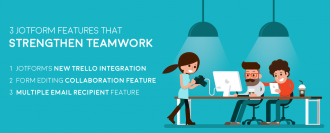Collaboration is fundamental to a successful business. When teams come together and combine their knowledge and experience, they can create innovative products, solve thorny customer problems, and achieve big things.
For small companies, collaboration usually occurs naturally and is fairly straightforward. But when your organization reaches a point where you have multiple locations, lots of employees, and a large customer base, the way you collaborate must evolve in kind.
That’s where enterprise collaboration systems enter the picture. Techopedia defines these systems well:
An Enterprise Collaboration System (ECS) is an information system used to facilitate efficient sharing of documents and knowledge between teams and individuals in an enterprise… [These] solutions include a variety of enterprise communication tools, including email, video conferencing, project management software and collaborative software.
Enterprise collaboration systems make collaboration among large groups simpler in three key ways:
- They improve transparency. Tracking and auditing are typically built into most ECSs, so team members can see not only their own activities but those of their teammates. This keeps everyone in the know and informed about how projects are progressing and initiatives are panning out.
- They facilitate communication. ECSs typically provide multiple ways for team members to communicate with one another and with management — threaded discussions, one-on-one and group messaging, conference calls, automatic notifications, and so on.
- They centralize work. Why use five different apps when you can use just one to accomplish the same goals? ECSs bring together broad feature sets that often eliminate the need for multiple apps an organization has cobbled together, which helps to break down work silos.
Clearly ECSs can be advantageous. If you’re in the market for a system for your growing organization, below are five options to consider.
Enterprise collaboration systems: 5 options
1. Jotform Teams
Jotform Teams enables enterprise collaboration through shared workspaces. For example, you can create a workspace for HR, finance, marketing, sales, customer service, and other departments within your company.
Jotform Teams is part of the larger suite of Jotform tools, including
- The powerful form builder
- Jotform Tables, a spreadsheet-database hybrid tool
- Jotform Workflows, an approval workflow builder
- Jotform Report Builder, a reporting and presentation tool
- Jotform Sign, an e-signature solution
- Jotform Apps, a no-code app builder
Together, these products form a comprehensive enterprise collaboration system that your teams can use to do all the activities required for seamless cooperation, including building a multitude of useful online forms, efficiently managing data, and developing insightful reports.
Features
- Centralized asset management
- User role assignments
- Access control
- Automation
2. Glasscubes
Glasscubes is another enterprise collaboration system that brings multiple capabilities together under one digital roof — namely, file sharing, project management, and information workflows.
Like Jotform, Glasscubes lets you create workspaces for different needs. For example, you can create a workspace dedicated to each of your clients. These workspaces are where your team communicates and shares information with each client team.
Features
- Approval workflows
- Threaded discussions
- Information requests
- SSL encryption
3. ClickUp
ClickUp bills itself as an “all-in-one productivity platform,” which fits it right in with other enterprise collaboration systems on this list.
Teams can use the platform to plan, organize, and collaborate on their work with features like whiteboards, chat, and task management. Users often cite a steep learning curve with the platform, but they also say it has a robust set of capabilities.
Jotform actually has a ClickUp integration you can use for your organization.
Features
- Document creation
- Real-time chat
- Dashboards
- Goal tracking
4. Happeo
Happeo is an enterprise collaboration system and AI-powered intranet that helps teams manage knowledge and internal communications. You can build branded intranet pages with a drag-and-drop interface to share knowledge across the organization. Teams can easily search all organizational pages with the platform’s universal search.
Features
- Channel and community building
- Life cycle management
- 21+ third-party integrations
- Page analytics
5. Basecamp
Basecamp is a project management-focused collaboration system that’s known for its campfire feature, a real-time group chat teams can use to quickly ask questions and get answers. As expected of a platform geared toward project management, you can add to-dos, assign users to complete them, and set due dates.
Features
- Message board
- Scheduling
- Real-time group chat
- File sharing
Enterprise collaboration systems come in all shapes and sizes. The above options are a curated selection that offers a variety of feature sets. Try each one to see which works best for your organization.
Photo by Gustavo Fring






























Send Comment: